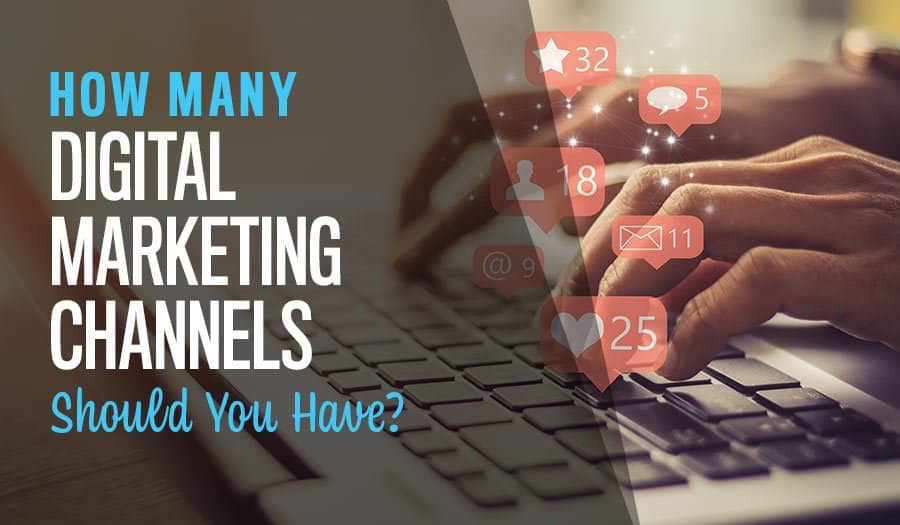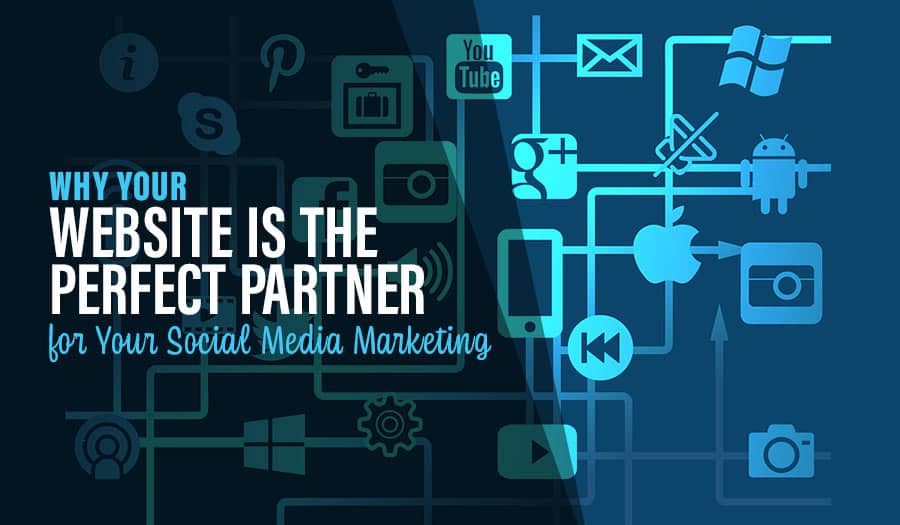In the Data Age, there’s no question that digital marketing is the leading type of marketing and has, in fact, spun off into an industry far larger than traditional marketing ever was. This is because almost every consumer in the world is on the internet and using search engines to find the products and content they want. So whether your customers are local or global, digital marketing is an essential part of building awareness, interest, and loyalty to your brand.
Because digital marketing is so huge, it’s important to refine your efforts to the channels of digital marketing that work best for your brand. Some brands try to hit all the bases with varying levels of success, while others limit themselves to as few as three focused marketing channels. Really, your brand should probably fall somewhere in between. But which channels are the right channels, and how many do you really need for your brand?
Let’s dive in with an in-depth view of the digital marketing channels available and why you might choose to focus on each one.
How Many Digital Marketing Channels Should Your Business Have?
Website
Every single digital marketing campaign must start with a website. The website is where your customers (and business partners and even future employees) look first for the low-down on your brand. Your website will become the portal to all online interactions and the source of all reliable information on your products and services. It is your contact point, landing page directory, and online store wrapped all into one.
Landing Pages
Landing pages are essential to the entire digital marketing process. When you create an ad with a link, where does it go? To a custom landing page you’ve created for the purpose. Every product and service page is a type of landing page, as are the special offer pages and your homepage. Treat them with the top-of-funnel respect they deserve.
E-Commerce Portal
Your website is also your online store, even if you sell through other platforms more prolifically. Your online store is the first and last word on product details, warranties, prices, and more. Direct purchases are almost always better than platform purchases. So perfect that e-commerce store experience for your customers through your website.
Membership Portal
If you have a loyalty membership program (and you should) then your website is also a portal to accounts, profiles, and on-site socialisation. Make sure your customer portal is easy and rewarding to navigate. This will be what keeps loyal customers coming back and might win over new customers with new accounts.
Blog
Your blog is another key element of online marketing. With an in-house writer or content service, you can keep your website stocked with freshly published, interesting, and industry-relevant posts that will draw organic inbound web traffic. The more interesting, useful, and in-demand your blog content is, the better.
Downloadable Content
Along similar lines to your blog is downloadable content. White papers, infographics, and so on can form powerful draws but only if you have the right kind of audience. Casual customers will not want to ‘sign up’ or ‘download’ to see content, while B2B customers with a longer shopping arc and more investment in data will be more interested in gated high-end content.
Social Media
Social media used to be a single category of digital marketing. Now it’s separated into a half-dozen or more unique and very distinctive platforms. The essence of social media marketing is to build a following of people who are interested in your brand, products, services, or just the fun content of your posts. This following becomes a brand-supportive community that can help build brand awareness, customers, and overall popularity.
Choose your social media platforms and campaign strategy wisely. Each platform is different. Facebook, for example, favours longer posts while Instagram focuses on making stories out of images. Twitter is for casual-fun messages while LinkedIn is all about B2B business-like communications. Your brand might reflect differently in each platform, and your social media strategy should change platform by platform.
There’s also no need to tackle every popular social media platform. We suggest you choose the top three that best suit your brand and expand cautiously from there as your campaign plan and marketing resources allow.
You may also want to read our review of Twitter Vs Facebook Vs Instagram Vs LinkedIn.
Mobile App(s)
Yes, a mobile app is absolutely a digital marketing channel. Some brands have multiple mobile apps partly for this purpose. A mobile app has its own unique appeal, especially if you build some handy functionality and catchy game elements into the design. A few tools, widgets, or features that stand on their own will make your apps pop regardless of their core design.
If your company has one mobile app, it should also act as a customer account portal and access customer services provided by your brand. If your brand has multiple apps, then feel free to spread out the functionality based on what makes sense for your features, offerings, and audience preferred styles.
Question-Answer Sites
One interesting digital marketing channel that has popped up recently is the question-answer site marketing tactic. Websites like Quora and Stack Exchange among others give the general public a place to ask questions and for experts inside the general public to answer them. Where is the advertising angle? Find questions that your brand would be an expert at answering. Answer with that helpful expert-opinion in a friendly and personable way, like you would in a conversation. Then sign your messages with a simple footer that the expertise was provided by the company.
This tactic stems from forum marketing, but question-answer sites are friendlier and it is not considered spam to offer a professional opinion from the perspective of your brand. Especially if you really do helpfully answer questions.
Email Campaigns
Email marketing is one of the oldest forms of digital marketing. In fact, it may be the original. Email marketing is, essentially, sending branded emails that might potentially encourage someone to buy for the first time or to come back and buy again. There are many forms of email marketing but three overall categories: Newsletters, promotional emails, and functional emails.
Newsletters
Newsletters are for recipients who have signed up. Maybe they made an account, maybe they joined a mailing list, or perhaps they directly signed up for specific newsletters. These should be value-packed content that promotes the brand without direct advertising. Newsletters often include stories, updates, fun facts, and industry insights based on what your audience is interested in. The purpose of a newsletter is to keep readers engaged with the brand.
Promotional
Promotional emails might be sent to members or sent cold to unconnected email addresses. Promotional emails are more likey to include announcements of sales and discounts, provide coupons, or invite the recipient to a branded event. Promotional emails can be powerful, but they’re also the most likely to wind up in the Spam folder.
Functional
Functional emails are automatically triggered by visitor activity. If someone completes an order, for example, a functional email might be their emailed receipt and order confirmation. A functional email might trigger if someone abandons an e-cart, reminding them to return and complete the purchase. Functional emails are both necessary and potentially promotional.
PPC – SEM – Pay Per Click – Search Engine Marketing
PPC or Pay Per Click is the first and leading form of SEM, Search Engine Marketing. There are a lot of acronyms once you start heading into the search engine realm of digital marketing and even more opportunities to optimise your results.
PPC, specifically, is when you pay a search engine to show your ads in response to search results. Used correctly, it can generate even more “organic” page visits because you tie your PPC ads to specific keywords (and search parameters like location) related to your brand. You can use PPC to help potentially interested users easily find your brand and products.
The great thing about PPC is that you only pay when users click, not for ad showings. And once you start with PPC, you open a whole new can of worms for digital marketing options, so be prepared.
Webinars and Courses
Some brands thrive in the digital marketing field by offering online education. Webinars, courses, and even certificate programs can draw a huge crowd to your site, if you’re offering education that’s in high demand. Online education is highly valuable for modern professionals and students aiming for a strong career start.
By offering skills and certifications through an online portal, you can draw attention to your brand and provide a valuable resource for today’s professionals. Webinars and courses may require a lot of time to create, but if your business is already producing training material internally, consider altering it for marketing and profitable uses as well.
Affiliate Partnerships
Another way to market online is through someone else. Affiliate partners are e-celebrities and others who already have a large online following. Your brand pays these digital leaders to mention and promote your products. Or you can go so far as to craft a unique campaign that incorporates your affiliate partners. The most common type of affiliate is a popular blogger who is paid for mentions and links in their articles.
Voice and Smart Homes
Voice search is becoming the next big thing. With smart homes more than “on the rise” and AIso occupying most mobile devices now, voice search is the quickest and easiest way for many people to get information they want. Voice search is used to find brick-and-mortar store locations almost as often as it is used to read Wikipedia.
Optimising for voice search is a significant task to undertake but in the next five years you’ll be glad you did it early and are ready to adapt to whatever voice evolves next. You might also consider growing your app into a smart home skill.
Podcasting and Live Streaming
Finally, there’s podcasting and live video. Podcasting is recording an audio or video session of… something. Honestly, it can be anything from how-to videos to staged rap battles. Whatever your audience likes, whatever they will tune in to watch week after week, you can turn that into a digital marketing channel. By creating audio and/or video content for your fans, you can flesh out your social media, blog, website, and independent podcast that can build its own online fan following.
How many digital marketing platforms does your brand need? The more the merrier, but always feel confident in choosing a few to start with and building your campaign out from there. Contact us today for more insights into digital marketing and building the right campaign for your brand!
Let Sydney’s leading Web Design Agency take your business to the next level with a Pixel Fish Small Business Website.
Check out some of our latest Website Design projects.
Further Reading
10 Top Reasons to use Gravity Forms
8 Social Media Plugins for Your WordPress Website
Read More
5 Steps to a Small Business Marketing Strategy Anyone Can Follow
How to Build a Blog that Actually Helps Your Inbound Marketing
5 Steps to Optimise Your Digital Marketing on a Limited Budget
5 Genuine Ways How Influencer Marketing Drives Results
5 Effective Ways to Nurture Your Leads and Boost Engagement
How to Keep Your Website Relevant so Your Customers Return for More



